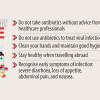Antimicrobial resistance: The overlooked pandemic

Back in 2013, the head cardiologist of a renowned hospital in Bangladesh suggested breathing pacemakers as a last resort to keep my grandmother alive. She had developed an infection that turned out to be resistant to antibiotics. My grandmother had spent most of her life in a conservative village where women barely go to hospitals, since most doctors are male. Instead, they rely on quick remedies like antibiotics, recommended by pharmacists. The pacemaker could only keep her breathing for three more months.
Long before antibiotics were available, a simple wound often meant the end of someone's life due to a bacterial infection. Beginning in the 1950s, greater availability of antibiotics not only changed that, but also reduced child mortality and improved life expectancy rates. Major surgeries or even cancer chemotherapy would not be possible without effective treatment of bacterial infection.
But these lifesaving drugs, when misused, allow disease-causing bacteria and fungi to grow uncontrollably, and no longer respond to antibiotics designed to kill them. This defiance is popularly known as antimicrobial resistance or AMR, and the pathogens that don't respond to a variety of antibiotics are commonly referred to as "superbugs." A Lancet study estimated 1.27 million deaths associated with bacterial AMR in 2019, more deaths than by HIV or malaria.
And yet, globally, the use of antibiotics is still on the rise. A recent study covering 204 countries shows a 46 percent increase (of daily doses per 1,000 people) in antibiotic consumption between 2000 and 2018. South Asia is among the regions where antibiotic resistance continues unabated for all ages.
So, while antibiotic use in high-income countries plunged in recent times, it has increased rapidly in low-income countries. For instance, in high-income countries, the antibiotic consumption rate (daily doses per 1,000 population) dropped by four percent between 2000 and 2015. Conversely, its consumption increased by 77 percent in low-income countries. In the absence of diagnostic facilities in these countries, both doctors and patients trust antibiotics under the assumption that every disease is bacterial.
Unlike many low-income countries, Bangladesh is self-sufficient with the capacity to produce antibiotics locally. Besides, the country has a very high pharmacy density (7.2 per 10,000 population) compared to other countries, including the EU and the US. They are also worried about extensive out-of-pocket expenses in the medical system. Hence, they prefer a quick fix to an illness by plucking low-hanging fruits like antibiotics. Given this setting and the people's rising incomes, more people can now afford expensive antibiotics.
These trends have been exacerbated even more by the pandemic. For instance, the perception of antibiotics as "big" medicine is one of the key social drivers of antibiotic use in Bangladesh during the pandemic. Also, the lack of confidence to treat severe Covid cases and commercial pressure drove the use of expensive antibiotics.
Misuse in the form of overdose or underdose is another key concern. A study in rural Bangladesh found that 48 percent of antibiotics purchased were less than one day's dose.
World Health Organization data suggest that almost 90 percent of patients in Bangladesh are resistant to ciprofloxacin (one of the leading antibiotics), compared to only 11.5 percent of patients in the UK. Even worse, a professor from Bangabandhu Sheikh Mujib Medical University told The Daily Star that 70 percent of deaths at ICUs are due to AMR. Beyond humans, a very prominent presence of antibiotic residual chemicals in livestock and water surfaces can also be observed.
A week before I moved to the US, my brother took me to a pharmacy in Dhaka. Our initial plan was to buy some basic medicines. But his pharmacist friend suggested that we get some antibiotics as well, presuming that they are difficult to get in the US. We ended up buying 11 different types of medicines, including four antibiotics. And we needed no prescription.
This is not uncommon. A review of the literature reveals that non-prescription antibiotic use accounts for 58 percent in Asia, with 76 percent of non-prescription antibiotics being bought from pharmacies. Similarly, a study in Bangladesh found that 68 percent of clients visiting pharmacies do so either through self-referral or without a prescription. The thriving drug industry and aggressive marketing often push such exploitation. The Bangladesh Institute of Development Studies (BIDS) reveals that pharmaceutical companies employ 65 percent of their manpower to influence doctors (and pharmacy owners) to generate prescriptions.
In 2021, the WHO declared AMR as a major public health threat. But it is also highlighted as the overlooked pandemic. Substantial data gap is a major obstacle to global health governance. Most of the studies on AMR rely on a single data source (IQVIA MIDAS) that mostly covers high-income countries and one low-income country. To overcome this, global spending must be increased to improve the data collection system at the country level. In Bangladesh, the existing efforts to curb AMR mostly targets supply-side factors such as selling antibiotics without prescription. But lack of enforcement meant that the High Court's ruling to this end in 2019 hardly made any difference on the ground. The lack of access to accurate information for consumers as well as to farmers remains mostly unaddressed.
As a way forward, directing attention to rational antibiotic use in hospitals and livestock farms with effective diagnostics protocol is highly recommended. For Bangladesh, implementing an effective regulatory framework with robust surveillance and enforcement at medical facilities, pharmacies, and food-producing animal farms will be effective. Similar regulations in Chile also resulted in a decrease in antibiotic utilisation. But this effort must be accompanied by a nationwide awareness-building campaign involving doctors, community influencers, and the media to change the social norm.
The Bangladesh AMR Response Alliance (BARA) was launched in partnership with FAO in 2016 with a similar objective, but their outreach remains very limited. For a broader approach, the Antibiotic Awareness Day in Europe can be a good model. But any further disregard will force vulnerable groups such as the elderly, children, and low-income populations to bear the greatest brunt of increasing AMR.
Kazi Md Mukitul Islam is a PhD candidate at Boston University. His research interests include medical sociology.

 For all latest news, follow The Daily Star's Google News channel.
For all latest news, follow The Daily Star's Google News channel. 












Comments